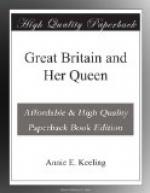[Illustration: Lord Macauley.]
There are many other great writers, working in other fields, whom we may claim as belonging altogether or almost to the Victorian age. Within that period lies almost entirely the brilliantly successful career of Macaulay, essayist, poet, orator, and historian. For the last-named role Macaulay seemed sovereignly fitted by his extraordinary faculty for assimilating and retaining historical knowledge, and by the vividness of imagination and mastery of words which enabled him to present his facts in such attractive guise as made them fascinating far beyond romance. His “History of England from the Accession of James II,” whereof the first volumes appeared in 1849, remains a colossal fragment; the fulness of detail with which he adorned it, the grand scale on which he worked, rendered its completion a task almost impossible for the longest lifetime; and Macaulay died in his sixtieth year. Despite the defects of partisanship and exaggeration freely and not quite unjustly charged upon his great work, it remains a yet unequalled record of the period dealt with, just as his stirring ballads, so seemingly easy of imitation in their ringing, rolling numbers, hold their own against very able rivals and are yet unequalled in our time.
[Illustration: Thomas Carlyle.]
Macaulay was not the first, and he is not the last, of our picturesque historians. It was in 1837 that Carlyle, who four years before had startled the English-reading public by his strangely worded, bewildering “Sartor Resartus,” brought out his astonishing “History of the French Revolution”—a prose poem, an epic without a hero, revealing as by “flashes of lightning” the ghastly tragedy and comedy of that tremendous upheaval; and in 1845 he followed up the vein thus opened by his lifelike study of “Oliver Cromwell,” which was better received by his English readers than the later “History of Friedrich II,” marvel of careful research and graphic reproduction though it be. To Carlyle therefore and to Macaulay belongs the honour of having given a new and powerful impulse to the study they adorned; dissimilar in other respects, they are alike in their preference for and insistent use of original sources of information, in their able employment




